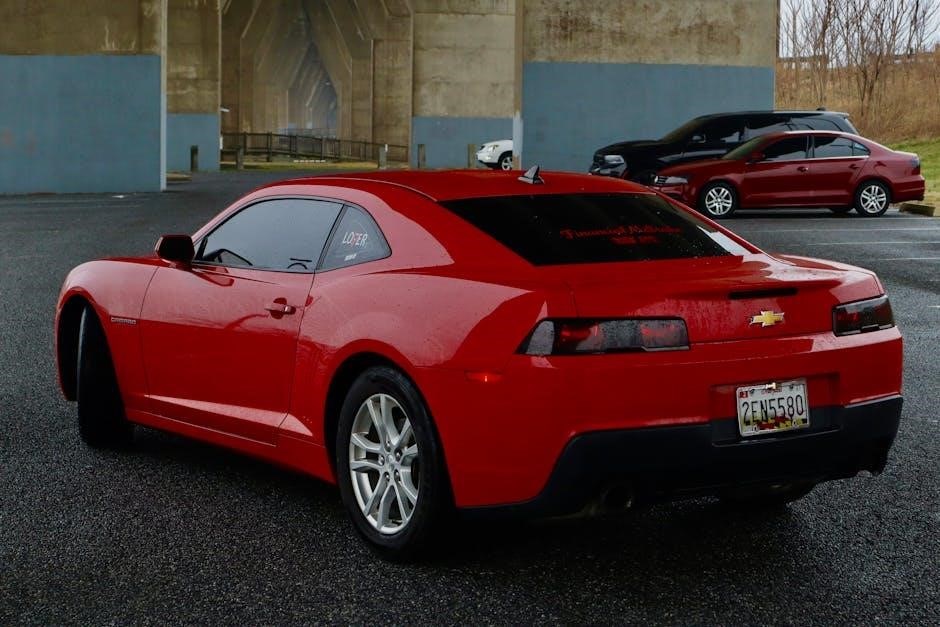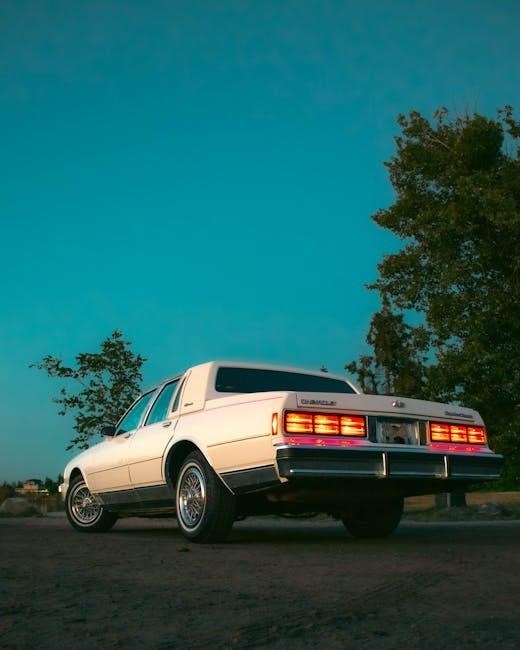The Chevy Silverado is a reliable pickup truck renowned for its robust 4-wheel drive system, designed to enhance traction and control on various terrains. However, some models experience issues with manual 4WD engagement, often linked to faulty components like actuators or motors, which can hinder performance in off-road conditions.

Common Causes of Chevy Silverado Manual 4-Wheel Drive Not Engaging
Common issues include faulty actuators, broken encoder motors, failed shift motors, and malfunctioning vacuum solenoids, all of which can disrupt the system’s ability to engage properly.
Faulty Actuator
A faulty actuator is a common culprit behind the Chevy Silverado’s manual 4-wheel drive system failing to engage. The actuator is responsible for physically engaging the 4WD system by moving the transfer case into the correct position. Over time, it can wear out or become damaged, leading to issues like clicking noises or a complete failure to activate. Symptoms often include the 4WD light blinking or staying on, and the system not responding to manual shifts. Diagnosing a faulty actuator involves checking for electrical connectivity and ensuring no fuses are blown. If the actuator is found to be malfunctioning, replacing it is typically the only solution. This issue is particularly prevalent in older models, where wear and tear can compromise the actuator’s performance. Regular maintenance can help identify such problems early, preventing further damage to the drivetrain.
Broken Encoder Motor
A broken encoder motor is another common issue that can prevent the Chevy Silverado’s manual 4-wheel drive system from engaging. The encoder motor plays a crucial role in controlling the transfer case’s position and ensuring smooth transitions between 2WD and 4WD modes. When the encoder motor fails, the system loses the ability to accurately detect the current gear position, leading to engagement problems. Symptoms may include erratic behavior of the 4WD indicator light, difficulty shifting into 4WD, or a complete system failure. Diagnosing a broken encoder motor involves testing the motor’s electrical connections and verifying its operation. If the motor is found to be faulty, it must be replaced to restore proper function. This issue is often linked to wear and tear or electrical malfunctions, emphasizing the importance of regular system checks to prevent unexpected breakdowns.
Failed Shift Motor
A failed shift motor is a primary culprit when the Chevy Silverado’s manual 4-wheel drive system refuses to engage. The shift motor is responsible for transferring power from the transmission to the drivetrain, enabling the transition between two-wheel and four-wheel drive modes. When this motor fails, the system cannot physically engage, leaving the vehicle stuck in 2WD. Common indicators of a faulty shift motor include unusual noises during attempted engagement or a complete lack of response from the 4WD system. In some cases, the motor may still operate intermittently, causing unpredictable behavior. Diagnosis involves testing the motor’s electrical circuit and ensuring proper communication with the vehicle’s control module. Replacement of the shift motor is typically required to resolve the issue, as repairs are often impractical. This problem is frequently attributed to wear and tear or electrical malfunctions, highlighting the need for regular maintenance to prevent such failures.
Malfunctioning Vacuum Solenoid
A malfunctioning vacuum solenoid is another common issue that can prevent the Chevy Silverado’s manual 4-wheel drive system from engaging properly. The vacuum solenoid plays a crucial role in controlling the transfer case, which distributes power to the front and rear axles. When the solenoid fails, it disrupts the vacuum signal required to activate the 4WD system, leaving the truck stuck in two-wheel drive. Symptoms of a faulty solenoid may include a clicking noise when attempting to engage 4WD or a complete lack of response. The problem is often caused by electrical issues, corrosion, or dirt buildup in the solenoid. To resolve this, the solenoid must be cleaned or replaced, and the vacuum lines should be inspected for any blockages or damage. Proper function of the vacuum solenoid is essential for reliable 4WD operation.

Troubleshooting Steps for 4-Wheel Drive Engagement Issues
Troubleshooting begins with checking the 4WD selector switch, fuses, and electrical connections. Ensure the transfer case is in the correct gear and test the actuator for proper function.
Checking the 4-Wheel Drive Selector Switch
The 4-wheel drive selector switch is a critical component that controls the engagement of the system. To diagnose issues, inspect the switch for visible damage or wear. Ensure it is securely connected to the transfer case. If the switch is faulty, it may fail to send the proper signal, preventing the system from engaging. Testing the switch involves checking its electrical connections and ensuring it activates the transfer case motor. If the switch is malfunctioning, replacing it with a genuine OEM part is recommended to restore functionality. Regular maintenance and inspection of the selector switch can prevent unexpected engagement issues, ensuring smooth operation of the 4-wheel drive system in the Chevy Silverado.
Inspecting Fuses and Electrical Connections
Inspecting the fuses and electrical connections is a crucial step in diagnosing 4-wheel drive engagement issues. Locate the fuse box and check for blown fuses related to the 4WD system. Ensure all electrical connections are clean, secure, and free from corrosion. Pay particular attention to the ground wires, as faulty grounding can disrupt system communication. If a fuse is blown, replace it with the correct amperage rating. Additionally, verify the connections at the transfer case, actuator, and selector switch. Loose or damaged wires can prevent the system from engaging properly. Addressing these electrical issues can often resolve the problem without requiring extensive repairs. Regular inspection of these components helps maintain the reliability of the 4-wheel drive system in your Chevy Silverado.
Testing the Transfer Case
Testing the transfer case is essential to diagnose 4-wheel drive engagement issues. Start by shifting the truck into neutral and engaging the 4WD system. Listen for any unusual noises or vibrations, as these can indicate internal damage. Check the transfer case for leaks, as low fluid levels can prevent proper operation. If equipped, use a multimeter to test the transfer case’s electrical connections for continuity. Ensure the encoder motor and actuator are functioning correctly, as these components control the transfer case’s engagement. If the transfer case fails to engage, it may require replacement. Always consult a professional if internal damage is suspected, as improper repairs can lead to further complications. Regular testing helps ensure the 4-wheel drive system operates smoothly in your Chevy Silverado;

DIY Repairs for Common 4-Wheel Drive Problems
For manual 4-wheel drive issues, replacing the front actuator or encoder motor can often resolve engagement problems. Use a torque wrench and socket set for safe, effective repairs.
Replacing the Front Actuator
Replacing the front actuator is a common solution for manual 4WD engagement issues in the Chevy Silverado. Start by disconnecting the battery to prevent electrical shocks. Locate the actuator on the front axle housing and remove the mounting bolts. Unplug the electrical connector and set the old actuator aside. Install the new actuator securely, ensuring all bolts are tightened properly. Reconnect the electrical connector and test the 4WD system by shifting into 4HI or 4LO while driving at a moderate speed. If the issue persists, further troubleshooting may be necessary, such as checking the transfer case or shift motor.
Fixing the Encoder Motor
The encoder motor in the Chevy Silverado plays a crucial role in the 4-wheel drive system by sending signals to the control module. If it fails, the 4WD may not engage properly. To fix this, start by disconnecting the battery to ensure safety. Locate the encoder motor, typically found on the transfer case, and remove the mounting bolts. Carefully unplug the electrical connector and set the old motor aside. Install the new encoder motor, securing it with the provided bolts. Reconnect the electrical connector and test the 4WD system by shifting into 4HI or 4LO while driving at a moderate speed. If the issue persists, further inspection of the transfer case or shift motor may be required. Regular maintenance can help prevent such issues in the future.

Preventive Maintenance Tips
Regularly inspect the actuator, encoder motor, and electrical connections to ensure proper function. Clean or replace components as needed and check fluid levels to prevent wear.
Regular Maintenance of the 4-Wheel Drive System
Regular maintenance is crucial to ensure the Chevy Silverado’s 4-wheel drive system functions optimally. Owners should periodically inspect electrical connections, actuators, and the transfer case for wear or damage. Lubricating moving parts and checking fluid levels can prevent premature wear. Additionally, ensuring all ground wires are secure and free from corrosion helps maintain proper system operation. It’s also recommended to test the 4WD system periodically under controlled conditions to identify potential issues early. By following a consistent maintenance routine, Silverado owners can minimize the risk of common problems like engagement failures and extend the lifespan of their 4-wheel drive components.
Avoiding Common Mistakes
When dealing with the Chevy Silverado’s 4-wheel drive system, it’s essential to avoid common mistakes that can worsen issues or damage components. One major error is neglecting regular inspections of electrical connections and ground wires, which can lead to system malfunctions. Another mistake is forcing the manual shifter into gear without ensuring the vehicle is in neutral, potentially damaging the transfer case. Additionally, ignoring dashboard warnings or service messages can delay necessary repairs, causing more severe problems. Overreliance on 4WD in unsuitable conditions, such as high-speed highway driving, can also strain the drivetrain. By following proper maintenance routines and avoiding these pitfalls, owners can ensure their Silverado’s 4-wheel drive system operates smoothly and reliably in all conditions.
When to Seek Professional Help
Consult a professional if issues persist after DIY troubleshooting, especially for complex problems like transfer case control module malfunctions or internal drivetrain damage, to prevent further system harm.
Transfer Case Control Module Issues
A faulty Transfer Case Control Module (TCCM) can disrupt 4WD functionality, causing the system to malfunction. The TCCM acts as the brain of the 4-wheel drive, managing electronic signals to engage or disengage the system. If it fails, the truck may refuse to switch modes, leading to persistent 4WD issues. Symptoms include the service light illuminating, inability to engage 4WD, or unintended mode shifts. Diagnosing TCCM problems requires specialized tools and expertise, making it a task best handled by professionals. They can reprogram or replace the module if necessary, ensuring the 4-wheel drive system operates smoothly once again. Ignoring such issues can lead to further drivetrain damage, emphasizing the importance of prompt action.
Drivetrain Inspections
Drivetrain inspections are crucial when diagnosing 4-wheel drive issues in the Chevy Silverado. Over time, components like driveshafts, axles, and universal joints can wear out, causing vibration or misalignment that disrupts 4WD functionality. Inspecting these parts for damage, excessive play, or lubrication issues is essential. Additionally, checking the front and rear differentials for proper fluid levels and condition ensures optimal performance. If any drivetrain component is compromised, it can prevent the 4-wheel drive system from engaging or disengaging smoothly. Regular inspections help identify potential problems early, preventing costly repairs. A thorough drivetrain check is often recommended when 4WD issues persist, as underlying mechanical damage can exacerbate the problem if left unaddressed.

